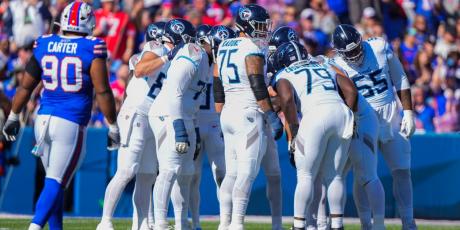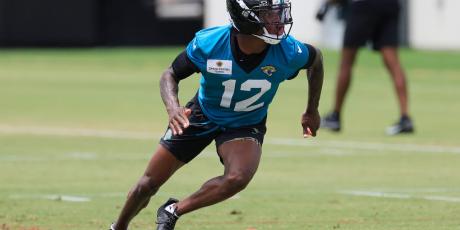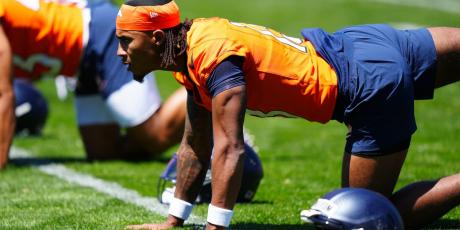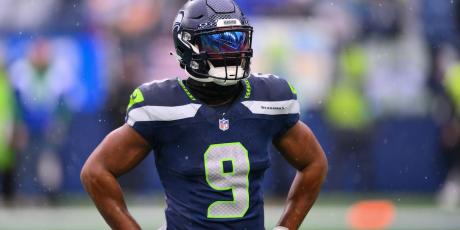We are 4for4 Fantasy Football, and this is how we draft.

Full disclosure: I am a big fan of the How I Work series at LifeHacker. Several months ago I even sent them an unsolicited copy of How Josh Works, but the lack of response indicated perhaps they were not interested in how a 30-something fantasy nerd works out of his parents' basement. (I have since moved!)
Coincidently, LifeHacker recently interviewed New York Times Best Selling author Matthew Berry, who perhaps painted a more professional version of how the fantasy analyst gets work done. (Side note: You can see a copy of Berry's book Fantasy Life, which I wholeheartedly endorse, above on my real-life work desk.)
Anyway, subscribers often ask, with so many different tools and features available at 4for4, what should they be using on draft day? My general response is they should try out the various things that we have to offer and see what works for them. Some folks swear by our Printer Friendly Cheat Sheet, others use the Full Impact Value-Based Top-200, still others refuse to draft without PC Drafter, and of course auction drafters look to our Customizable Auction Cheat Sheets. There are countless resources available to 4for4 subscribers.
It is our goal at 4for4 Fantasy Football to bring you everything you need to draft a winning team and make the best decisions all season long. I know how I draft, but thought I'd turn it over to our top-shelf staff of 4for4 Scouts and Contributors. Below are their responses to the question, "How do you draft?"
I'm Josh Moore, and this is how I draft:
There was a time in my life when I used to take any number of materials and computer programs to my fantasy draft, but these days I like to keep it simple. Today, 4for4's customizable Top-200 Value Based Rankings paired with our one-page positional cheat sheet are enough to get me through just about any fantasy draft.
I start with the Top-200 Value Based rankings, optimized for my roster format and scoring rules. I will use that as a guideline for my first 8 or so draft picks, taking value largely into consideration, but also considering team needs to some extent. For instance, even if value tells me I should draft my 4th RB in four rounds, if I only start 2 I'll probably look the the next best non-RB value on my list. When value is close, I'll go with personal preference. I also have some basic things in mind about the nature of this year's draft class (like QB is deep, etc.), but am committed to remaining flexible and drafting as value dictates.
Once I have my starting lineup more or less filled out, I'll switch to the positional cheat sheet and modify my strategy a bit depending on how the draft is going and the makeup of my team as it stands.
If my draft is online, which most of them are, I always make sure to arrive an hour or so early to set my default draft list in the draft room to correspond to my Top-200 list. This alone eliminates some stress and panic when looking for the next player on my list. It allows me to focus on enjoying what should be one of the best days of the year, draft day.
- Josh Moore, Owner, Editor
I'm John Paulsen, and this is how I draft:
I like to be a minimalist on draft day. I print out a copy of our customized Top 200 rankings along with a one-page by-position cheatsheet. I'll sometimes use a computer to keep track of picks, but sometimes its just quicker and easier to cross names off of a list.
I'll use the Top 200 list for my first several picks, but won't go strictly by it if I have an overall draft plan (i.e. draft a TE early, wait on QB, start RB/RB, etc.). It's more of a guide to tell me the relative value of each player. If I'm drafting near the turn, I'll keep track of the rosters of the teams drafting behind me so that I can potentially take advantage of their needs. For example, if the two teams drafting before my 6th round pick already have a QB, I know that I don't need to take one at 5.10.
Once I have my "core roster" together -- starting lineup plus a backup at both RB and WR -- I'll ditch the Top 200 list and use the by-position cheatsheet to complete my draft.
If it's an online draft, Josh's advice is spot on -- it's a lot easier to draft if the customized Top 200 rankings are already in the system. That way, you always have a queue of 15-20 players that you know are good values at any given pick.
- John Paulsen, Senior Editor
I'm Dale Lolley, and this is how I draft:
I used to take five magazines and the updated injury list. Now, I just use 4fo4. I plug my league rules into Full Impact, spit out the projections from your site and cross off the few guys I don’t want under any circumstances – ie. no Patriots, been burned by Belichick’s injury list too many times. Makes everything nice and simple.
- Dale Lolley, Steelers Beat Reporter & 4for4 Scout
I'm Bob Harris, and this is how I draft:
Bare bones. I hit the site that's holding the draft with my personal position-by-position rankings in front of me (with key sleeper and value plays highlighted). I optimize my rankings to meet the scoring system and lineup requirements. I don't use or follow an overall ranking, I tend to go with the flow of the draft. I focus on my own needs. I don't worry what the guys around me are doing other than to take advantage when I feel value has been left on the board. Since I draft mostly with other fantasy professionals, the need to reach up a bit to secure players you want is a given. I work methodically at building my starting lineup while trying to ignore runs if the position that suddenly takes off isn't one I was already interested in.
I keep an ADP ranking handy for occasional checks when it comes to deciding between players that are close.
I draft online almost exclusively, so I keep my iPad handy with the live draft rolling on it in case I have an issue with my primary machine.
- Bob Harris, 4for4 Scout, FSWA Hall of Famer & Senior Editor of FootballDiehards.
I'm Matt De Lima, and this is how I draft:
There's really no method to my madness. I usually go in blind these days. I might double-check some ADP numbers during the draft to make sure I'm not reaching. Beyond that, I go by gut so I don't have much to offer here.
- Matthew De Lima, 4for4 Scout
I'm Brandon Niles and this is how I draft:
I used to read as many magazines as I could get my hands on when I was younger and when the internet wasn't nearly as relevant of a factor in fantasy sports. I would then use that knowledge to create my own convoluted rankings system and make my own draft sheets. While a lot of fun, this was often extremely time consuming. In the late nineties, when the internet became far more commonplace and fantasy sports was just starting to become "the thing to do," I began to expand my research a bit and ultimately developed a strategy I still use today.
Today, I use 4for4 rankings, because they give me the very best idea of value as I'm drafting. I also use my own rankings, which is basically 4for4's rankings jumbled a bit to factor in my own personal bias and preferences. Finally, I make a depth chart for every team using 4for4's fantasy depth charts and news sources, as well as my own guesses on who might win jobs. I take these things to the draft and I walk in with a strategy that I tell myself is "value" based.
Ultimately, I try to draft away from the crowd. I try not to lock into one position at certain rounds, but rather I try to accrue as many projected top-5 players as I can. Often I'll end up with a top 10 back and two top 5 WR's but I sometimes wind up RB-heavy this way. I also identify players at different positions who I think should be available later, but I think have early round production potential. Last year, Matt Ryan, Doug Martin, and Randall Cobb were on that list for me (along with a few players that I won't care to mention). I often feel more prepared to wait at a position if I have some later targets in mind.
In summary... value, don't get locked into a position, and try to walk in with an idea of who you might be able to steal late. And that's how I draft.
- Brandon Niles, 4for4 Scout
I’m Scott Pagel and this is how I draft:
For those of you who take part in the Discuss Your Team forum or have read my Perfect Draft Series articles, you likely already know how I draft…
But to give you an idea of how I got to this point, I began playing fantasy football back in the mid-90s in a scoring-only league that got points for TDs and bonuses for 100 rushing and receiving yards and 300 passing yards. I did my research online and took a hand-written piece of paper to the draft with my rankings on it. My fear was running out of names because the lists weren’t always very long.
Through the years and into the early 2000s, my hand-written sheet became an .xls file, so it at least looked a little organized. And as fantasy football became a bigger deal, there was much more information around. It was in that time I formed my own league with my friends, and the need to keep track of all the rosters became necessary. I printed up roster sheets for everyone to write their teams on, but it wasn’t a perfect system.
Soon after that I began working at 4for4 Fantasy Football, and site owner at the time Greg Alan introduced me to the PC Drafter program. He suggested using it to do Perfect Draft articles and go against the computer to try to outscore it. I was skeptical at first, but once I began using it I was sold on it pretty quick. Next thing I knew I was the geek who started taking his laptop to live drafts…
I love using PC Drafter. It’s my only draft day tool, not only for my rankings and my own drafting, but also to keep track of everyone rosters for my league, as well as being able to see who my opponents are picking and what their needs are – all at the same time. I admit, working at the site and doing my various duties, I absorb a lot of information each summer. So, coupling that with the PC Drafter program, I always feel prepared coming into every draft.
The only downfall to using the program is during live drafts where there is a timer, like Yahoo! drafts. That can get a little tricky, but it’s still possible to keep track online and on PC Drafter, as long as my twin toddlers are not climbing on me. I don’t always agree with who the program tells me to pick, but the great part about it is all the players are ranked for me based on my league settings. I like that I can see the overall rank of the all positions when it’s my turn, but also break it down by each position if I need to.
I’ve never been more successful playing fantasy football than when using PC Drafter.
- Scott Pagel, 4for4 Scout & PC Drafter Expert
I'm Pat Fitzmaurice, and this is how I draft:
I've always been a minimalist drafter. The less physical and digital clutter I'm burdened with, the better I seem to do. This is especially true of live drafts. Every year I do three live drafts in the same hotel conference suite over a single weekend -- three leagues with a lot of crossover membership among groups of friends. I only see some of these guys once a year, so I don't want to spend the entire day playing around with different programs on my laptop.
All I want to have in front of me when I draft are my own positional rankings and consensus expert rankings. There might be two or three times in a typical draft when I find myself with an either/or dilemma, and having the consensus rankings handy lets me see how the experts whose opinions I respect most (John Paulsen, etc.) feel about the players I'm debating.
Before a draft, I'll copy my standard or PPR rankings into a new file and determine whether I need to make any adjustments based on the league scoring system. If it's a somewhat unfamiliar scoring system, I'll spend a few minutes thinking about an overarching strategy that fits the scoring system. But I never commit to staying wedded to a single strategy. Flexibility is critical. Drafts are so unpredictable, you have to be willing to make changes midstream. When the unexpected happens, the proper path is usually illuminated like a path marked with candles.
- Pat Fitzmaurice, 4for4 Contributor
I'm Jonathan Bales, and this is how I draft:
I really prefer to do live drafts. I like the environment, and I also like to trade picks quite a bit, which you can't do on a lot of online sites like ESPN. I think trading picks makes drafts fair in that you're not stuck selecting players you don't really want; you can trade up or back and create a unique lineup in much the same way as an auction.
Heading into a draft, I typically have five sheets in front of me: one for each position and one that combines any positions that are allowed in the flex. So if there is a RB/WR/TE flex, I have one sheet with all of the running backs, wide receivers, and tight ends listed together.
Otherwise, I keep the positions apart. I'm one of the few who doesn't use a single big board. The reason is that I think position value shifts so much as the draft unfolds, rendering a single board useless. You should be drafting players based on their position, scarcity, opportunity cost, and relative value as your draft unfolds, not how you ranked them prior to knowing how your particular draft would unfold.
Basically, I use a minimalist approach on draft day. There's nothing on my boards other than the player name and his projected points. I've done all of the research heading into the draft, so I don't want to be bogged down with information when I'm on the clock. The only other thing I examine is Week 1 matchups. I do that to select my defense (second-to-last round) and kicker (last round), since I stream them based on the opponent.
- Jonathan Bales, Daily Fantasy Expert & Author of the Fantasy Football for Smart People series
I'm Andy Rioux and this is how I draft:
My theory on drafting is that you can never have too much information. Once upon a time, I played fantasy football when there was no internet. Magazines were where it was at. Although they’re now dated on draft day, I still enjoy reading some of them. They help reinforce your beliefs on certain players. In the end, the best asset at your draft is an up-to-date customized cheat sheet from 4for4.
As many know, I often vary my approach from year-to-year based on whether I think it’s a deeper or shallow class at both running back and wide receiver. I tend not to take quarterbacks too early, as I think you can win with a mid-range QB1 if the rest of your other positions are strong.
I vary my approach based on where I am drafting. Although I subscribe to the theory that I’d rather have difference makers at wide receiver or quarterback over a mid-level running back, if I’m picking early in the first round I’m almost always going to take a runner. If I’m picking later and don’t feel running back is deep, it’s a different story.
I head into every draft with a plan to draft a certain number of players at each position. For example, if I’m in a league with 16-man rosters, I usually aim to have 2 QB, 5 RB, 5 WR, 2 TE, 1 K, and 1 D going into the season. I feel that way you maximize your assets at the two most fluid positions in fantasy football. And if you feel super confident in your talent at those spots, maybe you only draft nine players and add an extra defense for matchup flexibility.
Obviously kickers and defenses aren’t going to be taken early, but I don’t always aim to fill all the open spots in my lineup first. If you can wait on a quality quarterback and tight end and obtain more assets at RB and WR, it’s worth it.
The key to every draft is being prepared for lots of different scenarios. You need to have an idea of what round you want to target certain positions, and then be prepared to change on the fly. Because the unexpected always occurs on draft day!
- Andy Rioux, 4for4 Scout
I'm C.D. Carter, and this is how I draft:
Drafting a fantasy football team that won't give you night terrors for 16 weeks, like a good shave, requires time more than anything.
It was the year after college, after my facial hair had taken a decidedly thicker, courser turn, that I knew the days of the quick shave were very much over. It was those speedy shaves -- a few strokes with the handy dandy electric razor -- that left me with cuts and missed spots and ingrown hairs and general discomfort. Time, and only time, was the solution: warming my face with a hot washcloth, using a pricey exfoliating cream to clear away the pesky dead skin, and carefully applying a generous amount of shaving cream proved critical in a nice, clean shave.
A reliable solution to a First World Problem, to be sure.
I've found it's the same in fantasy football drafting. Those who log in to the draft room five minutes before the first selection is made are at a distinct disadvantage. I take at least 40 minutes before the draft to review league rules, check my draft spot -- a critical element of draft day planning -- and rearrange rankings to my liking. This last part is critical, I think, since major sites' draft rankings seem so imposing to so many fantasy owners. Selecting a guy eight or 10 or 12 spots down the expert-generated list can feel like a direct challenge to the fantasy powers that be.
That's why setting your own ranks is critical. At least, I think it is.
I draft like I shave. You should too.
- C.D. Carter, 4for4 Contributor & author of How To Think Like A Fantasy Football Winner






















